How to identify fake PayPal new address added emails
Phishing/ScamAlso Known As: "PayPal - You Added A New Address" spam email
Get free scan and check if your device is infected.
Remove it nowTo use full-featured product, you have to purchase a license for Combo Cleaner. Seven days free trial available. Combo Cleaner is owned and operated by RCS LT, the parent company of PCRisk.com.
What kind of email is "PayPal - You Added A New Address"?
"PayPal - You Added A New Address" is an email spam campaign with several message variants. Essentially, these emails are disguised as alerts from PayPal claiming that a new address was added to the account. In some cases, there are mentions of an expensive purchase that the account's owner has not made.
It must be emphasized that these fake messages are not associated with the actual PayPal Holdings, Inc. This spam mail aims to deceive recipients into calling fake support lines, likely in order to trick them into permitting scammers to access their devices remotely. Note that these types of scams are linked to severe threats.
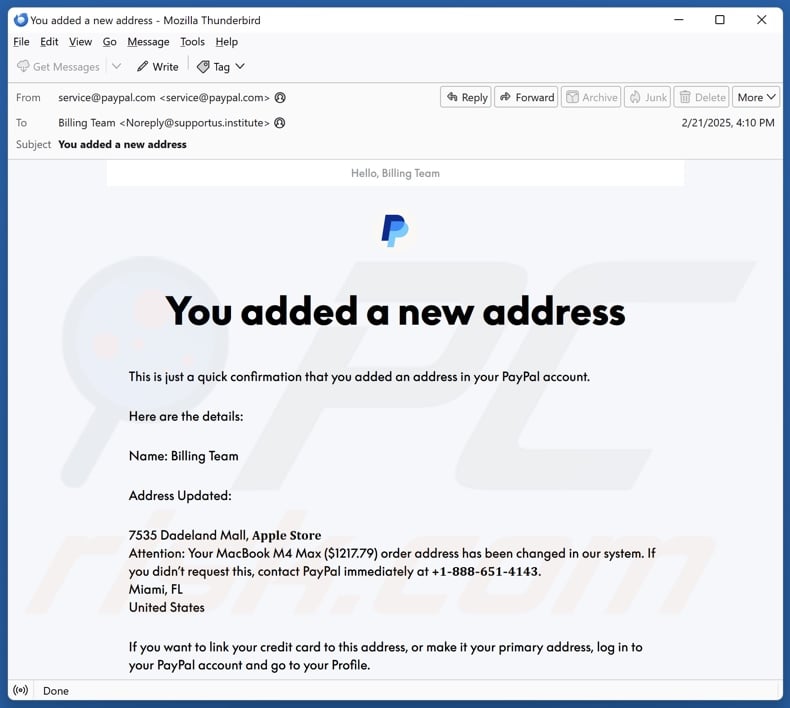
"PayPal - You Added A New Address" email scam overview
There are multiple emails associated with the "PayPal - You Added A New Address" campaign. The bodies of these letters and the subject lines can differ (e.g., "You added a new address", etc.). The key point of these fake alerts is that a new address has been added to the PayPal account.
Some of the spam emails mention an expensive order connected to the changed address (e.g., "MacBook M4 Max ($1217.79)", etc.). While other versions warn recipients outright of suspicious activities linked to an attempt to change the address. The emails urge to contact support by calling the provided number if they do not recognize this activity.
As mentioned in the introduction, the information in these messages is false, and this scam is not associated with the real PayPal Holdings, Inc.
What sets this campaign apart is that said emails can bypass recipients' spam filters. In some instances, the messages had legitimate mail headers, originating from PayPal's mail server.
This was achieved by the scammers adding a new address to a PayPal account in their possession and the scam message (i.e., about the fake purchase, supposed suspicious activity, etc.) into the "Address 2" form field. As this field is not (significantly) restricted by a character limit, the fraudulent message can be fully pasted into it. Once these changes are implemented on an account, PayPal automatically sends a confirmation email to the scammer's mail account.
The genuine notification (with the scam message inserted) was then forwarded to a Microsoft 365 account, which then sent it out to the email addresses in the mailing list. This list comprises the target (victim) emails; thus, they receive what appears to be a message from PayPal.
The first step for this campaign is to get recipients to call the fake helplines. The scammers (who pretend to be PayPal support) direct victims into downloading/installing remote access software. The promoted files were for legitimate programs (e.g., AnyDesk, ConnectWise ScreenConnect) but were preconfigured or otherwise modified.
How the scam operates once remote access is established may vary. It is highly likely that it follows the refund scam pattern, wherein victims are deceived into believing that they have been refunded an excessive amount and pressured into "returning it" (i.e., sending their own money to scammers).
Refund scams share many traits with technical support scams, and it is possible that "PayPal - You Added A New Address" also implements some elements.
Threats associated with these kinds of scams include high-risk malware infections, severe privacy issues, financial losses, and identity theft.
If you have allowed cyber criminals to access your device remotely – you must first disconnect it from the Internet. Afterward, remove the remote access program that the scammers used since they might not need your consent to reconnect. Lastly, perform a full system scan with an anti-virus and eliminate all detected threats.
| Name | "PayPal - You Added A New Address" spam email |
| Threat Type | Phishing, Scam, Social Engineering, Fraud |
| Fake Claim | New address has been added to the PayPay account. |
| Disguise | PayPal |
| Support Scammer Phone Numbers | +1-888-651-4143, +1-888-390-0146, +1-888-668-2508, +1-888-402-4642, +1-888-209-4243, +1-888-927-8780, +1-888-343-1947, +1-888-929-1886, +1-888-651-4959 |
| Detection Names (preconfigured AnyDesk .exe) | N/A (VirusTotal) |
| Detection Names (ConnectWise ScreenConnect) | Avast (Win32:MiscX-gen [PUP]), Fortinet (Riskware/ScreenConnect), Kaspersky (Not-a-virus:HEUR:RemoteAdmin.Win32.), Malwarebytes (Generic.Malware/Suspicious), Tencent (HackTool.Win32.ConnectWise.ha), Full List Of Detections (VirusTotal) |
| Symptoms | Unauthorized online purchases, changed online account passwords, identity theft, illegal access of the computer. |
| Distribution methods | Deceptive emails, rogue online pop-up ads, search engine poisoning techniques, misspelled domains. |
| Damage | Loss of sensitive private information, monetary loss, identity theft, possible malware infections. |
| Malware Removal (Windows) |
To eliminate possible malware infections, scan your computer with legitimate antivirus software. Our security researchers recommend using Combo Cleaner. Download Combo CleanerTo use full-featured product, you have to purchase a license for Combo Cleaner. 7 days free trial available. Combo Cleaner is owned and operated by RCS LT, the parent company of PCRisk.com. |
Refund scam spam campaign examples
"Payment For Bitdefender", "Zoom Antivirus Plus Subscription", "AT&T", "Apple Security Releases", and "Adobe Invoice" are just a few articles on refund scam campaigns.
Spam mail is used to promote various scams, including phishing, tech support, sextortion, etc. Malware is also proliferated through these emails.
Spam messages are often poorly written and riddled with grammatical/spelling mistakes, but they can also be competently put together and even convincingly disguised as mail from legitimate entities (e.g., companies, service providers, institutions, organizations, etc.). Therefore, we highly recommend exercising caution with incoming emails, PMs/DMs, SMSes, and other messages.
How do spam campaigns infect computers?
Spam campaigns spread malware as attachments or download links. Infectious files come in various formats, e.g., executables (.exe, .run, etc.), archives (ZIP, RAR, etc.), documents (Microsoft Office, Microsoft OneNote, PDF, etc.), JavaScript, and so on.
Merely opening such a file can be enough to initiate the infection chain. Some formats need additional actions to trigger malware download/installation. For example, Microsoft Office files require users to enable macro commands (i.e., editing/content), while OneNote documents need them to click embedded files or links.
How to avoid installation of malware?
Incoming mail must be approached with caution. Attachments or links in suspect emails and other messages must not be opened, as they can be harmful or virulent.
However, malware is not proliferated exclusively via spam mail. Therefore, we recommend being careful while browsing since the Internet is rife with fraudulent and malicious content.
Additionally, all downloads must be made from official and verified sources. Another recommendation is to activate and update software using legitimate/functions provided by legitimate developers, as illegal activation ("cracking") tools and third-party updates can contain malware.
It is essential to have a dependable anti-virus installed and kept up-to-date. Security programs must be used to run regular system scans and to remove detected threats. If you've already opened malicious attachments, we recommend running a scan with Combo Cleaner Antivirus for Windows to automatically eliminate infiltrated malware.
Text presented in the "PayPal - You Added A New Address" spam email letter:
Subject: You added a new address
Hello, Billing Team
PayPal
You added a new address
This is just a quick confirmation that you added an address in your PayPal account.
Here are the details:
Name: Billing Team
Address Updated:
7535 Dadeland Mall, Apple Store
Attention: Your MacBook M4 Max ($1217.79) order address has been changed in our system. If you didn’t request this, contact PayPal immediately at +1-888-651-4143.
Miami, FL
United States
If you want to link your credit card to this address, or make it your primary address, log in to your PayPal account and go to your Profile.
Since this address is a gift address, you can send packages to it with just a click.
Please note that you can't link your credit card to a gift address. If you'd like to make this your primary address, log in to your PayPal account and go to your Profile.
If you didn't make this change, let us know right away. It's important to let us know because it helps us make sure no one is getting into your account without your knowledge.
PayPal
Help & Contact | Security | Apps
Twitter Instagram Facebook LinkedIn
PayPal is committed to preventing fraudulent emails. Emails from PayPal will always contain your full name. Learn to identify phishing
Please don't reply to this email. To get in touch with us, click Help & Contact.
Not sure why you received this email? Learn more
Copyright © 1999-2025 PayPal, Inc. All rights reserved. PayPal is located at 2211 N. First St., San Jose, CA 95131.
PayPal RT000542:en_US(en-US):1.0.0:f668200733ace
Appearance of the "PayPal - You Added A New Address" spam email (GIF):
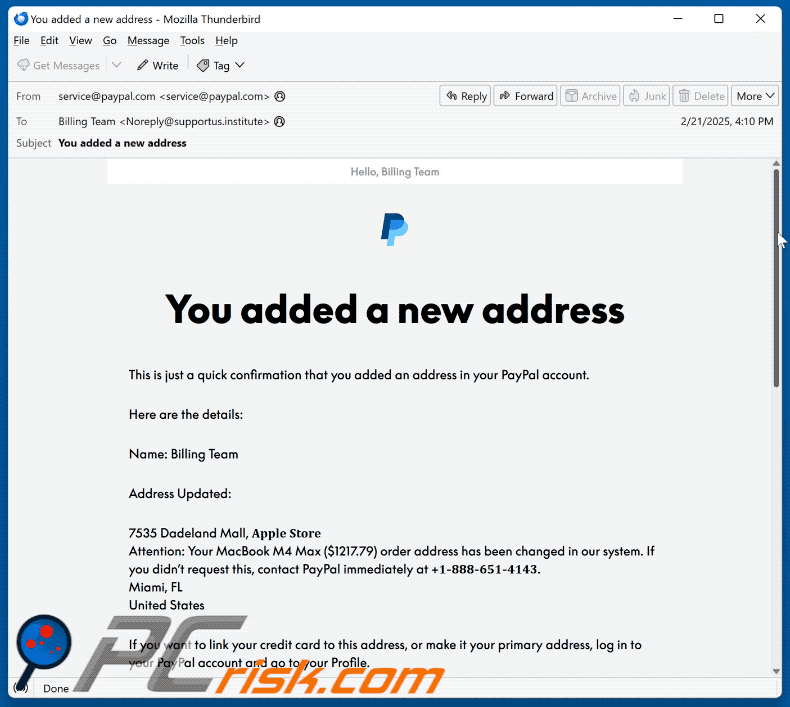
Screenshot of another variant of the "PayPal - You Added A New Address" spam email:
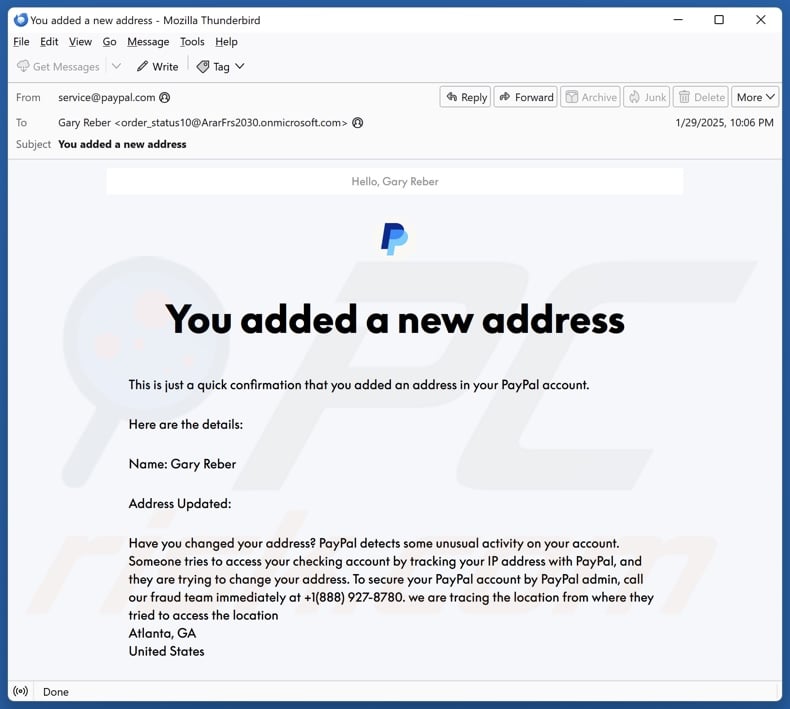
Text presented in this email variant:
Subject: You added a new address
Hello, Gary Reber
PayPal
You added a new address
This is just a quick confirmation that you added an address in your PayPal account.
Here are the details:
Name: Gary Reber
Address Updated:Have you changed your address? PayPal detects some unusual activity on your account. Someone tries to access your checking account by tracking your IP address with PayPal, and they are trying to change your address. To secure your PayPal account by PayPal admin, call our fraud team immediately at +1(888) 927-8780. we are tracing the location from where they tried to access the location
Atlanta, GA
United States
If you want to link your credit card to this address, or make it your primary address, log in to your PayPal account and go to your Profile.
Since this address is a gift address, you can send packages to it with just a click.
Please note that you can't link your credit card to a gift address. If you'd like to make this your primary address, log in to your PayPal account and go to your Profile.
If you didn't make this change, let us know right away. It's important to let us know because it helps us make sure no one is getting into your account without your knowledge.
PayPal
Help & Contact | Security | Apps
Twitter Instagram Facebook LinkedIn
PayPal is committed to preventing fraudulent emails. Emails from PayPal will always contain your full name. Learn to identify phishing
Please don't reply to this email. To get in touch with us, click Help & Contact.
Not sure why you received this email? Learn more
Copyright © 1999-2025 PayPal, Inc. All rights reserved. PayPal is located at 2211 N. First St., San Jose, CA 95131.
PayPal RT000542:en_US(en-US):1.0.0:f798261743d80
Screenshot of the website promoted by this spam campaign for downloading the ConnectWise ScreenConnect:
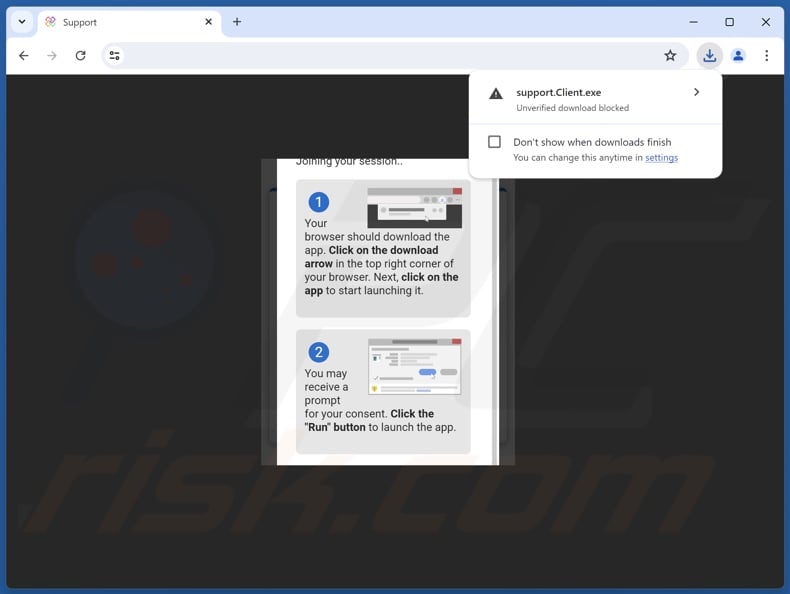
Screenshot of the preconfigured AnyDesk executable promoted by this spam campaign:
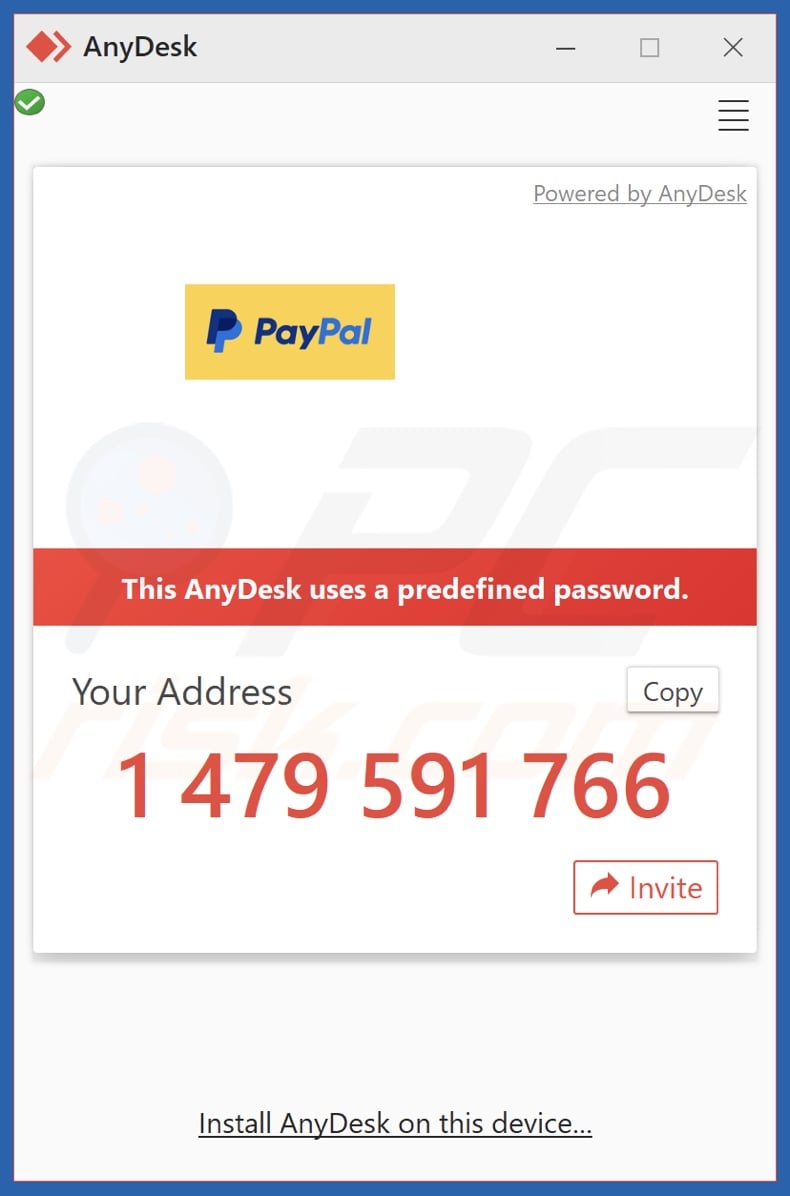
Instant automatic malware removal:
Manual threat removal might be a lengthy and complicated process that requires advanced IT skills. Combo Cleaner is a professional automatic malware removal tool that is recommended to get rid of malware. Download it by clicking the button below:
DOWNLOAD Combo CleanerBy downloading any software listed on this website you agree to our Privacy Policy and Terms of Use. To use full-featured product, you have to purchase a license for Combo Cleaner. 7 days free trial available. Combo Cleaner is owned and operated by RCS LT, the parent company of PCRisk.com.
Quick menu:
- What is "PayPal - You Added A New Address" spam email?
- Types of malicious emails.
- How to spot a malicious email?
- What to do if you fell for an email scam?
Types of malicious emails:
![]() Phishing Emails
Phishing Emails
Most commonly, cybercriminals use deceptive emails to trick Internet users into giving away their sensitive private information, for example, login information for various online services, email accounts, or online banking information.
Such attacks are called phishing. In a phishing attack, cybercriminals usually send an email message with some popular service logo (for example, Microsoft, DHL, Amazon, Netflix), create urgency (wrong shipping address, expired password, etc.), and place a link which they hope their potential victims will click on.
After clicking the link presented in such email message, victims are redirected to a fake website that looks identical or extremely similar to the original one. Victims are then asked to enter their password, credit card details, or some other information that gets stolen by cybercriminals.
![]() Emails with Malicious Attachments
Emails with Malicious Attachments
Another popular attack vector is email spam with malicious attachments that infect users' computers with malware. Malicious attachments usually carry trojans that are capable of stealing passwords, banking information, and other sensitive information.
In such attacks, cybercriminals' main goal is to trick their potential victims into opening an infected email attachment. To achieve this goal, email messages usually talk about recently received invoices, faxes, or voice messages.
If a potential victim falls for the lure and opens the attachment, their computers get infected, and cybercriminals can collect a lot of sensitive information.
While it's a more complicated method to steal personal information (spam filters and antivirus programs usually detect such attempts), if successful, cybercriminals can get a much wider array of data and can collect information for a long period of time.
![]() Sextortion Emails
Sextortion Emails
This is a type of phishing. In this case, users receive an email claiming that a cybercriminal could access the webcam of the potential victim and has a video recording of one's masturbation.
To get rid of the video, victims are asked to pay a ransom (usually using Bitcoin or another cryptocurrency). Nevertheless, all of these claims are false - users who receive such emails should ignore and delete them.
How to spot a malicious email?
While cyber criminals try to make their lure emails look trustworthy, here are some things that you should look for when trying to spot a phishing email:
- Check the sender's ("from") email address: Hover your mouse over the "from" address and check if it's legitimate. For example, if you received an email from Microsoft, be sure to check if the email address is @microsoft.com and not something suspicious like @m1crosoft.com, @microsfot.com, @account-security-noreply.com, etc.
- Check for generic greetings: If the greeting in the email is "Dear user", "Dear @youremail.com", "Dear valued customer", this should raise suspiciousness. Most commonly, companies call you by your name. Lack of this information could signal a phishing attempt.
- Check the links in the email: Hover your mouse over the link presented in the email, if the link that appears seems suspicious, don't click it. For example, if you received an email from Microsoft and the link in the email shows that it will go to firebasestorage.googleapis.com/v0... you shouldn't trust it. It's best not to click any links in the emails but to visit the company website that sent you the email in the first place.
- Don't blindly trust email attachments: Most commonly, legitimate companies will ask you to log in to their website and to view any documents there; if you received an email with an attachment, it's a good idea to scan it with an antivirus application. Infected email attachments are a common attack vector used by cybercriminals.
To minimise the risk of opening phishing and malicious emails we recommend using Combo Cleaner Antivirus for Windows.
Example of a spam email:
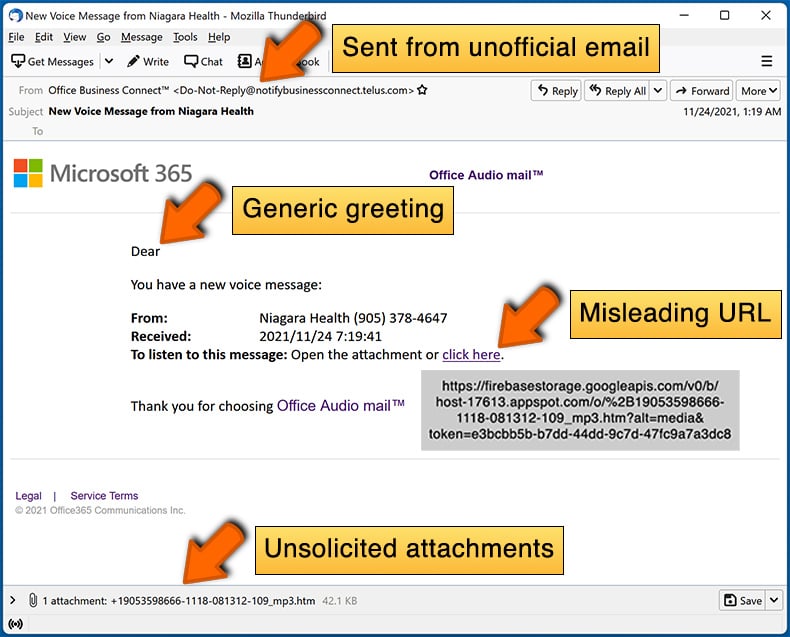
What to do if you fell for an email scam?
- If you clicked on a link in a phishing email and entered your password - be sure to change your password as soon as possible. Usually, cybercriminals collect stolen credentials and then sell them to other groups that use them for malicious purposes. If you change your password in a timely manner, there's a chance that criminals won't have enough time to do any damage.
- If you entered your credit card information - contact your bank as soon as possible and explain the situation. There's a good chance that you will need to cancel your compromised credit card and get a new one.
- If you see any signs of identity theft - you should immediately contact the Federal Trade Commission. This institution will collect information about your situation and create a personal recovery plan.
- If you opened a malicious attachment - your computer is probably infected, you should scan it with a reputable antivirus application. For this purpose, we recommend using Combo Cleaner Antivirus for Windows.
- Help other Internet users - report phishing emails to Anti-Phishing Working Group, FBI’s Internet Crime Complaint Center, National Fraud Information Center and U.S. Department of Justice.
Frequently Asked Questions (FAQ)
Why did I receive this email?
Spam emails are not personal, even if they include information relevant to the recipients. This mail is distributed in massive operations – therefore, thousands of users receive identical (or incredibly similar) messages.
I have allowed cyber criminals to remotely access my computer, what should I do?
If you have allowed cyber criminals to access your device remotely – firstly, disconnect it from the Internet. Secondly, uninstall the remote access program that the scammers used, as they might not need your consent to reconnect. Lastly, run a complete system scan and immediately remove all detected threats.
I have provided my personal information when tricked by this spam email, what should I do?
If you have provided your log-in credentials – change the passwords of all possibly exposed accounts and inform their official support. However, if you have disclosed other private information (e.g., ID card details, passport photos/scans, credit card numbers, etc.) – immediately contact the appropriate authorities.
I have read a spam email but didn't open the attachment, is my computer infected?
No, merely reading an email does not pose an infection threat. Devices are compromised when malicious attachments or links are opened/clicked.
I have downloaded and opened a file attached to a spam email, is my computer infected?
If the opened file was an executable (.exe, .run, etc.) – most likely, yes. However, you might have avoided the infection if it was a document (.doc, .xls, .pdf, .one, etc.). These formats may need additional actions (e.g., enabling macros, clicking embedded content, etc.) to jumpstart malware download/installation.
Will Combo Cleaner remove malware infections present in email attachments?
Yes, Combo Cleaner is capable of detecting and removing practically all known malware infections. Remember that performing a full system scan is essential since high-end malicious software usually hides deep within systems.
Share:

Tomas Meskauskas
Expert security researcher, professional malware analyst
I am passionate about computer security and technology. I have an experience of over 10 years working in various companies related to computer technical issue solving and Internet security. I have been working as an author and editor for pcrisk.com since 2010. Follow me on Twitter and LinkedIn to stay informed about the latest online security threats.
PCrisk security portal is brought by a company RCS LT.
Joined forces of security researchers help educate computer users about the latest online security threats. More information about the company RCS LT.
Our malware removal guides are free. However, if you want to support us you can send us a donation.
DonatePCrisk security portal is brought by a company RCS LT.
Joined forces of security researchers help educate computer users about the latest online security threats. More information about the company RCS LT.
Our malware removal guides are free. However, if you want to support us you can send us a donation.
Donate
▼ Show Discussion